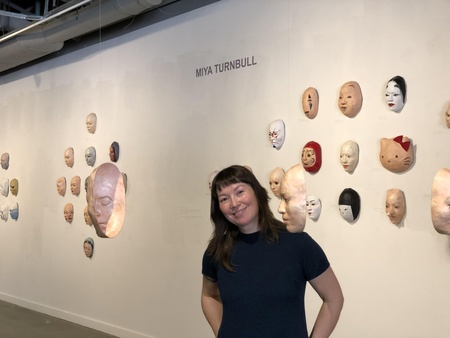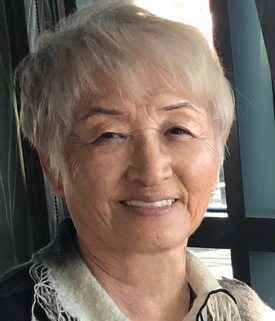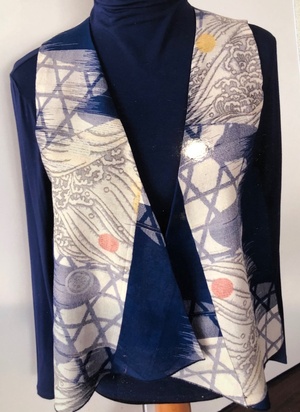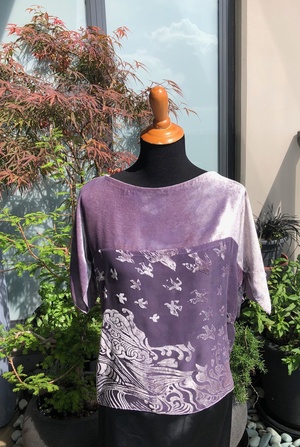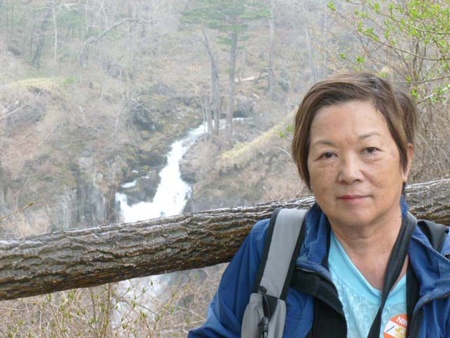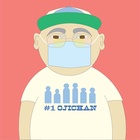Reflecting on the art of Yvonne Wakabayashi, second-generation artist Miya Turnbull (daughter of Alberta potter, Marjene Matsunaga Turnbull), and Barb Miiko Gravlin, each of their works has a place in the unravelling narrative of the Japanese Canadian Covid-19 story.
It is humbling to think that here are three generations of Japanese Canadians artists who continue to work at this most difficult time.
Looking at the art that Miya, Barb, and Yvonne are creating with a CoVid-19 lense then, what can be a more powerful expression of these times than Miya’s startling face masks? As a public school teacher, wearing a mask is now part of my new reality just as it is for my students and probably yours too. Miya reminds me too about the importance of politics in art. Clearly, this is no time for fence sitting.
Yvonne’s powerful fabric creations, born, literally, out of the material of her own mother’s old kimonos, she has chosen to recycle to “katazukeru” (tidy up) fabric into face masks, vests, and even a wedding dress. What powerful statements about the resilience, determination, and vision that is demanded by these times.
Finally, Miiko’s CoVid-19 time is being spent gathering her creative energies for the next phase of her career.
I would dare to say that post-WW2 JC generations are working at honing better selves and are beginning to creep out of the shadows of “shikkataganainess” (it-cannot-be -helpedness) finally, and beginning to find a happy ‘inbetween’’ place of identities that accommodates a range of ideas about JCness that the Issei never considered.
The graphic art that immediately sprung up after the murder of George Floyd was powerful and seismic: “I can’t breathe.” Marginalized people now feel some degree of safety to speak out about the racism, systemic injustices, bigotry, and society’s inherent “phobias” and hates that have in fact been with us for eons. The push is on.
In 2020, East Asians can take more collective pride in who and what we are. Now, thanks to social media, a racist incident in Vancouver goes viral and almost instantly becomes national and international news. Images and powerful words are evoked again being amplified by social media: Martin Luther King, Jr., Gordon Hirabayashi, James Baldwin, Malcolm X, Nelson Mandela, William Hohri, Art Miki, Yuri Kochiyama, Keith Haring, Black Lives Matter...
So, 50 years from now, in 2070 how will 2020 be remembered? Will my grade 5 students be any the wiser? Hopefully, they will be able to shake their heads in wonder at the ignorance of these times, thanking their lucky stars that they’ve evolved beyond these racist and hateful ways of being.
* * * * *
Mask Maker, Miya Turnbull (Halifax, Nova Scotia)
I feel very fortunate that I can be safe at home with my family during this pandemic. My husband and I both work from home, so that has made things easier in terms of childcare and stress about going into a workplace. The downside to the pandemic, other than obvious reasons, is that my main focus revolves more around family and ‘home life’ - cooking, baking, chores, homeschooling, gardening, etc, rather than working away in my studio. These things are wonderful and very important too, but it’s harder to find any time for myself - which means less time and space for creativity.
I am primarily a mask-maker, although I also work with a variety of other mediums such as painting, photography, multimedia, textiles, etc. It’s an interesting time to be making masks alongside the racism and mask dialogue that is happening surrounding the pandemic, because these issues are both pertinent to my art practise.
I make self-portrait masks as a way to try and separate myself from my physical image to transform and examine myself from an outside perspective, trying to highlight that we are often defined and labelled based on physical appearances, especially at first glance. My masks explore my personal heritage as half-Japanese and ‘in-between’, but I am also attempting to examine identity in a more broad sense, engaging and encouraging others to also see themselves - especially to see “beyond” the mask(s) that we might be wearing. Race isn’t the defining feature of a person but it is a part of who we are. We can learn so much by celebrating all our different colours and cultures and experiences. I am spending a lot of time right now examining my own privileges and how we all need to look inward to examine prejudices we may hold and not even realize.
There has been increased spotlight regarding masks in terms of safety - to help reduce the spread of Covid-19. I find it so interesting (and also concerning) the range of responses to masks and how it has now become incorporated into daily life. Face coverings are either being embraced or detested and they are evoking a lot of different emotions and have unfortunately become a political symbol. People are damned if they wear one, damned if they don’t, and everybody has an opinion of what others should be doing or not. Masks will be around for a while, I suspect, and it is interesting to see a new landscape of people with their faces covered.
I switched gears from making my very impractical weird art masks, to sewing fabric masks for my community. I have been doing this for free or by donation to BLM Solidarity Fund Nova Scotia. My favourite ones to sew are made from Japanese printed fabric and I have embroidered traditional Japanese designs with Sashiko thread onto hand dyed fabric to make a few very special ‘premium’ masks.
Of course, it wasn’t long after sewing away these masks, that it crossed over back into my artwork. For a while I was experimenting with making paper “Covid” masks that are a cross between these fabric masks with my photo based mask work and the results are very humorous and strange. I’ve also been making papier-mâché half-masks inspired by these fabric masks with my nose and lips on them (sometimes more than one set of lips for fun). This summer I have been able to make a few new art masks which feels really good but finding it hard to be creative.
It’s inevitable that there will be a lot of influence from this pandemic into my future artwork. All the things I’ve been feeling - the fear, the isolation, the stress, the sadness that I can’t travel to be with my family, feeling trapped, etc. will cross over into my art practise especially since my masks are so personalized as self-portraits.
I recently made a mask called “Feeling Discombobulated” and it was literally my facial features strewn about on my face, as if even my eyes and mouth don’t know where they are supposed to be. This sums up some of my recent emotions. I think about the passing of time in isolation, as can be seen in people’s lack of haircuts and gardens growing from seeds they started inside - how long a day can feel but also how quickly each week/month can go by. I also think about this ‘invisible’ enemy of the virus - how we have to treat each surface and every person including ourselves as infected and how I wish I could make it visible in order to fight it properly.
This pandemic has also shone a spotlight upon the inequalities and systemic racism in North America and we need to acknowledge these problems and decide how to make our time here meaningful and invoke positive change and take care of each other.
Miya’s instagram page @miyamask
* * * * *
Fabric Artist, Yvonne Wakabayashi (Burnaby, BC)
My theme is “Katazukeru” to undertake projects that will clear or finish or tidy up or down-size to a crowded space.
#1. I am very nostalgic and have the problem of holding on to things. Mottainai was what my mother taught me.
The photo shows my mother at over 70 years of age in a kimono. The inspiration came from the Tonari Gumi Seniors group fundraising event. We took apart damaged kimonos to recycle, redesign into simple, contemporary, affordable garments for a Seniors’ Fashion Show.
#2. My mother’s damaged and soiled kimono was taken apart and made into vests.
#3. Scraps of my shibori indigo samples were made into masks for family and friends.
#4. A commission fabric design for a wedding dress. To use up and ‘katazukeru’ the leftover scraps I got dyed and pieced together for this top.
Her website: yvonnewakabayashi.com
* * * * *
Abstract Artist, Miiko Barb Gravlin (Toronto, Ontario)
I live and work in a modest bachelor in North York, Ontario. I have to re-invent my space whenever I want to paint, bake or entertain).
Covid has affected me adversely within regards to creating art. My home doesn't have an artspace for creating painting now, as it’s restrictive - one room. So I've been going out a lot. When I'm ready to re-invent my living space, my art will take off in another direction. I visited Tokyo in 2018 for 12 days. I have fabulous photos from my walks and garden tours. Much had changed from 1965 when I was a student on my Canada Council art grant. I already envisage simple Japanese themes abstracted in colour and design in a smaller format inspired by that brief visit to Japan. It still needs to incubate… in the meantime, my head is in the sand. I seem to be able to focus on one thing this summer - to lose my Covid weight gain and regain exercise and hopefully with it - creative energy.
© 2020 Norm Ibuki


